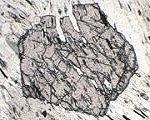Practical Aspects of Mineral Thermobarometry
Pyroxenes
Structure and sites
The pyroxene structure consists of single chains of tetrahedra extending along the c axis of the unit cell. There are two types of cation positions, designated M1 and M2. The smaller M1 sites lie between the apices of opposing tetrahedra, and are almost regular octahedra. M2 sites are larger, lie between the bases of tetrahedra, and are more distorted 6- or 8-fold sites.
|
|
Pyroxene structure, viewed obliquely along z. Yellow: SiO4 tetrahedra; red: smaller M1 cation sites; blue: larger M2 cation sites. |
End members and site allocations
The pyroxene formula unit M2.M1.T2O6 contains six oxygens and four cations: two in tetrahedral sites and one each in M1 and M2. The site preferences are as follows
- T (tetrahedra): Si, Al.
- M1 (small octahedron): Al, Cr, Fe3+, Ti, Fe2+, Mg.
- M2 (larger cation site): Ca, Na, Mn, Fe2+, Mg.
The most commonly-used end members are:
- Mg2Si2O6 : enstatite
- Fe2Si2O6 : ferrosilite
- CaMgSi2O6 : diopside
- CaFeSi2O6 : hedenbergite
- CaAl2SiO6 : calcium tschermak's molecule
- CaFe3+AlSiO6 : ferri-tschermak's molecule
- MgAl2SiO6 : magnesium tschermak's molecule
- NaAlSi2O6 : jadeite
- NaFe3+Si2O6 : acmite or aegirine
Al coordination
Although Al is commonly present only in small amounts in the pyroxene structure, it can occur in both tetrahedral and octahedral coordination. The amount of tetrahedral Al allocated by simply filling sites in sequence will be very sensitive to the accuracy of the Si analysis, and indeed the activity of any Al-pyroxene end member in all but the most Al-rich pyroxenes might be very sensitive to the way in which the formula is recalculated and the cations allocated to sites. It is worth remembering some general principles about Al coordination:
- High temperatures and relatively low pressures favour tetrahedral coordination for Al. Granulite-facies pyroxenes, therefore, tend to have tetrahedral Al greater than or equal to octahedral Al, and their Al content can be expressed in terms of the tschermak's molecule end members.
- High pressures favour increased coordination number. Jadeite is the typical Al-bearing pyroxene phase component. Blueschist and low- to medium-T eclogite-facies pyroxenes tend to have Si = 2 cations per formula unit, with negligible tetrahedral Al.
Ferric iron recalculation
For Fe-rich pyroxenes, recalculate ferric iron by the method of Droop (1987) on the basis of 4 cations per 6 oxygens. Be aware that the result is imprecise and sensitive to the accuracy of the other major constituents.
This page last modified 12 October 2004

